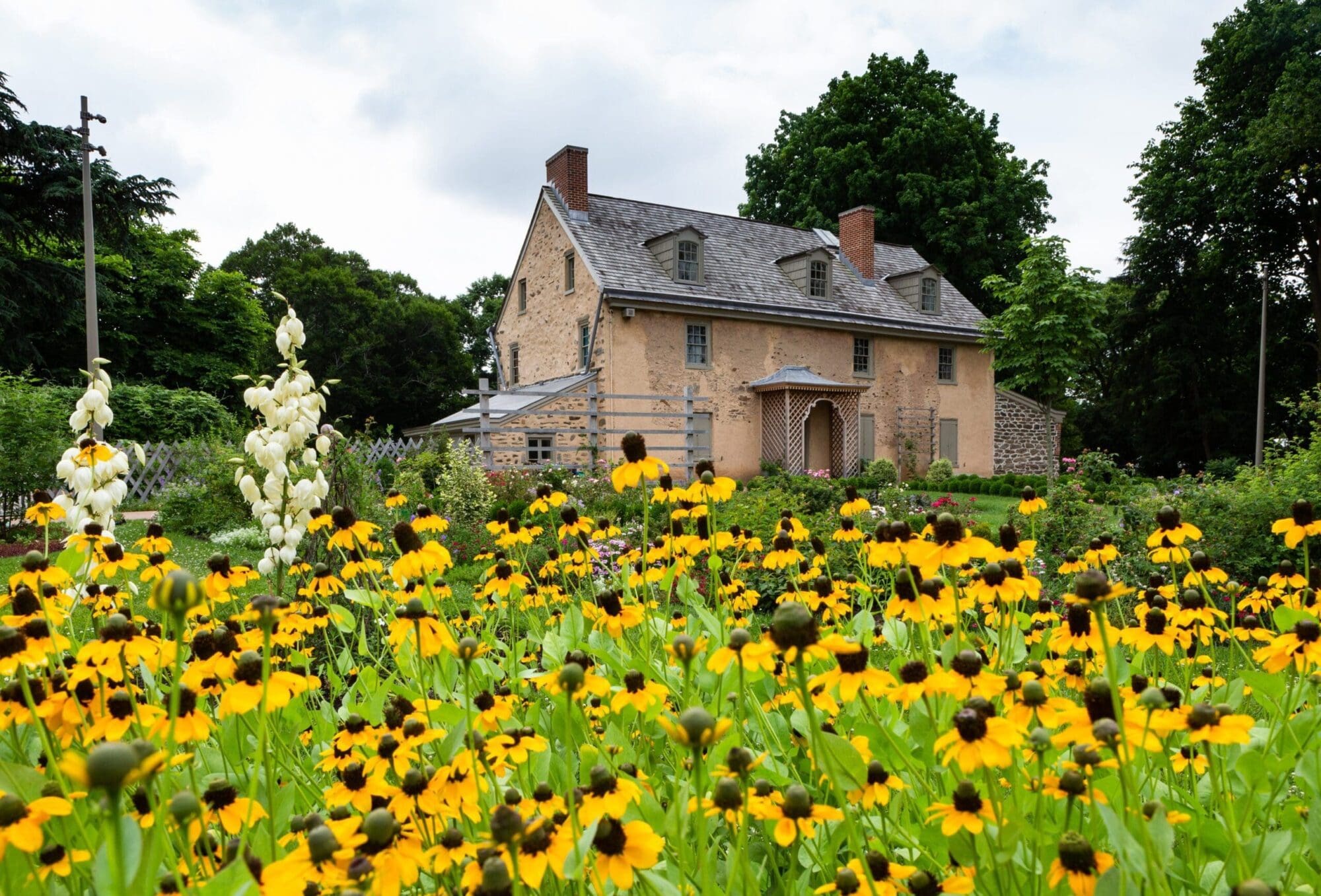Historic Buildings
A botanical landmark from the 1700s
Bartram’s Garden contains the Bartram family’s stone house and several other structures from the 1700s and 1800s. The Historic Bartram House and Garden were dedicated as a National Historic Landmark in 1963.
Explore our Historic Buildings

Historic Bartram House
John Bartram began building this stone house shortly after he purchased the land in 1728. Working in stages over 40 years, he incorporated elements he read about from classical Italian villas, such as carved Ionic columns and Baroque window surrounds. The stone is local bedrock, called Wissahickon schist, that was hand-quarried by Bartram and his family.
Walk onto the columned porch and you will find yourself at John Bartram’s front door, facing east towards the Schuylkill River. In his day, traffic from downtown Philadelphia primarily arrived by the river, rather than by road, so the front door faced the main entry to the site. Today, the view from the porch offers a re-creation of what might have been seen in the 1700s and 1800s: to the north is the Upper Kitchen Garden, which includes examples of plants a family could have grown to sustain their needs in a Philadelphia garden prior to 1830, and directly in front is the Common Flower Garden, a living collection of flowering plants John and William Bartram found particularly intriguing.

Barn
Believed to be the oldest standing barn in Philadelphia County, the Bartram Barn is an early example of a two-level Pennsylvania banked barn, built by John Bartram, Jr., in 1775. In the Bartrams’ time, animals would have been housed in the lower level, with access to the brick Barnyard, while the space that we currently use for programs and events would have been a hayloft.

Coach House, Dovecote & Stables
The Coach House was probably a small barn or nursery in the later Bartram period before being expanded into a carriage house by Philadelphia industrialist Andrew Eastwick, who purchased Bartram’s Garden in 1850. Today, the Coach House hosts programs and events on the first floor, while the second floor is home to our library and archives, which are free and accessible to the public by appointment.
On the river side of the Coach House and to the right of the large evergreen Magnolia grandiflora you’ll find a small garden bed dedicated to two very different displays. In the Spring you’ll find a part of our historic bulb collections featuring species tulips and fragrant hyacinths. In the Summer the bed explodes with examples of historically grown hothouse tropicals, tender perennials, and annuals.
The Bartram family’s original stables and dovecote are today home to our Welcome Center. Make this your first stop when you visit Bartram’s Garden.

Seed House & Historic Greenhouse
The Garden’s first greenhouse is located at the southern end of the Coach House complex, closest to the Historic Bartram House. It was built in 1760 out of local bedrock, called Wissahickon schist, that was hand-quarried by John Bartram and his family, and it was originally heated by a Franklin stove. Can you find John’s artistic carvings? If you have a pencil and paper on hand, try taking a rubbing of the carvings.
Eventually, Bartram’s Garden was home to as many as 10 greenhouses situated around the main house. They were heated by wood or, after 1820, anthracite coal. Today, our modern-day nursery complex is located further south on the site, and our greenhouses are insulated with plastic bubbles and heated with electric overhead heaters. Managed by our staff horticulturists and farmers, along with youth interns, our greenhouses grow plants for the Garden’s landscape, for the Sankofa Community Farm and community garden beds, and for sale to the public.

Cider Mill
The foundations for this riverfront mill were carved from bedrock, most likely by John Bartram. Apples were crushed in the circular trench by a wooden wheel, and then apple pomace was gathered and pressed between wooden boards to further extract the juice. This simple mill is an ancient design from Europe and probably processed fruit from orchards maintained by families from throughout the area and on both sides of the river.

Eastwick Hill & Bartram Hall
Overlooking the river from Eastwick Hill, the Eastwick Pavilion offers seasonal open-air space for public programs and private events.
Do you notice the unusual shape of the stone terrace outside the Pavilion? It traces the original footprint of Bartram Hall, an ornate 34-room villa that stood on this site from 1851 to 1896. Designed by Philadelphia architect Samuel Sloan, Bartram Hall was home to Philadelphia industrialist Andrew Eastwick, who purchased Bartram’s Garden from Ann Bartram Carr and her husband, Colonel Robert Carr. Eastwick reportedly loved Bartram’s Garden and vowed to preserve the botanical gardens and historic buildings.
After Eastwick’s death, his descendants faced pressure to convert the full site for industrial use, which would likely have been very profitable for them but would have destroyed the gardens entirely. Instead, nurseryman and botanist Thomas Meehan, who had previously worked for Eastwick as a gardener as well as at Kew Garden in England, led a national campaign as a member of Philadelphia’s City Council to preserve the site for public access. It succeeded! In 1891 Bartram’s Garden became part of the Philadelphia public park system.
You may also be interested in:

History & Research
Honoring shared histories in this legendary landscape.

Access Our Library & Archive
For on-site and assisted research.

Botanic Garden
America’s oldest preserved botanic garden is still growing.
Upcoming Events
There are no upcoming events, but check back soon for more information.
View CalendarHistory Blog
February 22, 2024
Joel's Wisdom in the Garden: Remembered by Mandy Katz
In fond memory of Curator Joel T. Fry (February 22, 1957–March 21, 2023) Almost one year past the date of Joel’s surprising illness and death, I still find myself in...
Read More


